1.7: Examples of 2-Dimensional Motion
- Page ID
- 18384
Circular Motion
Using what we just derived regarding the parallel and perpendicular components of acceleration, we turn now to the special case of an object traveling in a circle. The parallel part of the acceleration obviously always points tangent to the circle, which narrows it down to two directions at any given point on the circle. If the object is speeding up, then of course the tangent points in the direction of motion, and if it is slowing down, the tangent vector points in the direction opposite to the motion. The perpendicular part must be at a right angle to this tangent, which means it must be toward or away from the center of the circle. Unlike the tangent case, however, both directions are not possible. We can see this by considering the average perpendicular acceleration vector over two nearby moments in time:
Figure 1.7.1 – Direction of Centripetal Acceleration
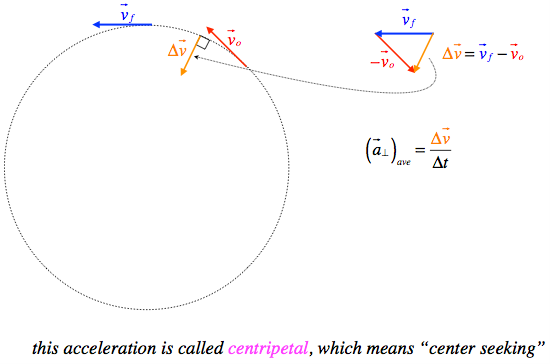
What is the magnitude of this centripetal acceleration? Well, it depends upon how fast the object is going (the faster it is moving, the more acceleration is required to turn in the same circle), and the radius of the circle (the acceleration is greater when the radius is smaller). Deriving the magnitude is left as an exercise, but the answer comes out to be:
\[ |\overrightarrow a_c | = \dfrac{v^2}{r} \]
Sometimes circular motion is the result of something rotating. For example, a bug on the outer rim of a rotating turntable travels in a circle, and therefore experiences centripetal acceleration. Well, when we deal with rotating objects we often know only the rate of its rotation (say in rpms), and we have to translate into linear motion to know the speed. There is a simple and standard way to do this.
Digression: Radians
If we are talking about rotational motion, we need to discuss how we measure such motion. We clearly don’t measure the speed of a spinning top or turntable in terms of meters per second, but rather how much it turns in a period of time. How does one measure the angle through which something turns? One way is to divide the full circle up into 360 equally-sized pie slices. The magnitude of one of these angles we call a 'degree.' But really this division is arbitrary. So why was 360º selected? Well, given that we often have to deal with slices of pie, we can avoid having to use fractional degrees if we select a number with lots of factors, and 360 certainly fits the bill – it is divisible by 2, 3, 4, 5, 6, 8, 9, 10, 12, 15, 18, 20, 24, 30, 36, 40, 45, 60, 120, and 180.
But there is no reason at all that divisibility needs to be our only criterion. In fact, we don’t even need to divide the circle into an integral number of pieces. For example, we could divide it into 7.5 pieces and call the size of each piece “1 flibber.” We can even translate between different systems of units: \(1^f\) = 48º.
But there is another criterion that leads to a definition of a measurement of angles that is different from degrees. Suppose we want a simple translation from angle to arclength (the distance traveled along the circular curve subtended by that angle). We know that traveling around an entire circle requires a journey of a distance equal to \(2 \pi\) times the radius of the circle. So going around some fraction of a circle requires a journey equal to that fraction times \(2 \pi r\). So if we divide the circle into an uneven number of pieces such that \(2 \pi\) of these pieces fit into the circle, then in these units you can calculate the arclength by just multiplying the angle measured in those units (called radians) by the radius of the circle:
If we want to translate between the speed that something is going around the circle to the angular speed at which the slice of the pie is being swept-out by this motion, we need only take a derivative:
This gives us an alternative way of expressing the centripetal acceleration:
\[ | \vec a _ c | = \frac{v^2}{r} = \frac{\left( r \omega \right) ^2}{r} = r \omega^2 \]
Example \(\PageIndex{1}\)
A bead is threaded onto a circular hoop of wire which lies in a vertical plane. The bead starts at the bottom of the hoop from rest, and is pushed around the hoop such that it speeds up at a steady rate. Find the angle that the bead's acceleration vector makes with the horizontal when it gets back to the bottom of the hoop.
- Solution
-
The tangential motion of the bead is in one dimension, so we can use the usual kinematics equations to describe its motion along the circle. Let's call the radius of the circle \( R\) and the final velocity \(v\). The tangential acceleration is constant, the bead starts from rest, and the bead travels one circumference, so using Equation 1.4.3, we get:
\[2a \Delta x = {v_f}^2 - {v_o}^2 \;\;\; \Rightarrow \;\;\; a_\parallel=\dfrac{\left(v^2-0^2\right)}{2\left(2\pi R \right)}=\dfrac{v^2}{4\pi R} \nonumber\]
The centripetal acceleration is toward the center of the circle, so it points upward and its magnitude is simply:
\[a_\bot=\dfrac{v^2}{R} \nonumber\]
The tangent of the angle that the full acceleration vector makes with the horizontal is the vertical component divided by the horizontal component, so:
\[\theta = \tan^{-1} \left(\dfrac{\dfrac{v^2}{R}}{ \dfrac{v^2}{4\pi R}}\right)=\tan^{-1} \left(4\pi \right) = 85^o \nonumber\]
Projectile Motion
For circular motion, we have the components of velocity changing in tandem in a specific manner to keep the path circular. Another – actually simpler – form of motion involves only a single fixed coordinate component of velocity changing, while the other components involve no change in velocity. What I am alluding to here is projectile motion, which comes about because the vertical component of motion is subject to constant acceleration (as we discussed when we talked about free-fall), while the horizontal component is unaffected by gravity’s influence. This kind of motion is only one small step from the free-fall we are already familiar with, in that it includes a totally independent horizontal component of motion that incorporates (to the extent that air resistance can be ignored) no acceleration. As simple as this sounds, a couple of examples muddy the waters a bit, and sorting them out is very instructive:
Example \(\PageIndex{2}\)
A hunter climbs a tree and fires a bullet directly at a monkey that is hanging from a branch of another tree at precisely the same height as the barrel of the hunter’s gun. The instant the bullet leaves the gun, the monkey lets go of the branch. Ignoring air resistance (and the size of the monkey - assume it is very small), what is the fate of the monkey?
- The monkey will be hit by the bullet.
- The bullet will pass beneath the monkey.
- The bullet will fly over the monkey’s head.
- Whether the bullet flies over the monkey’s head or passes beneath it depends upon how fast the bullet is moving when it leaves the barrel of the gun.
- What kind of jerk shoots a monkey?
- Solution
-
A (and E). The vertical motion of the monkey is independent of the horizontal motion, so in equal time spans, the bullet falls the same distance as the monkey. Since they started at the same level, they remain at the same level at all times, including when the horizontal position of the bullet equals the horizontal position of the monkey.
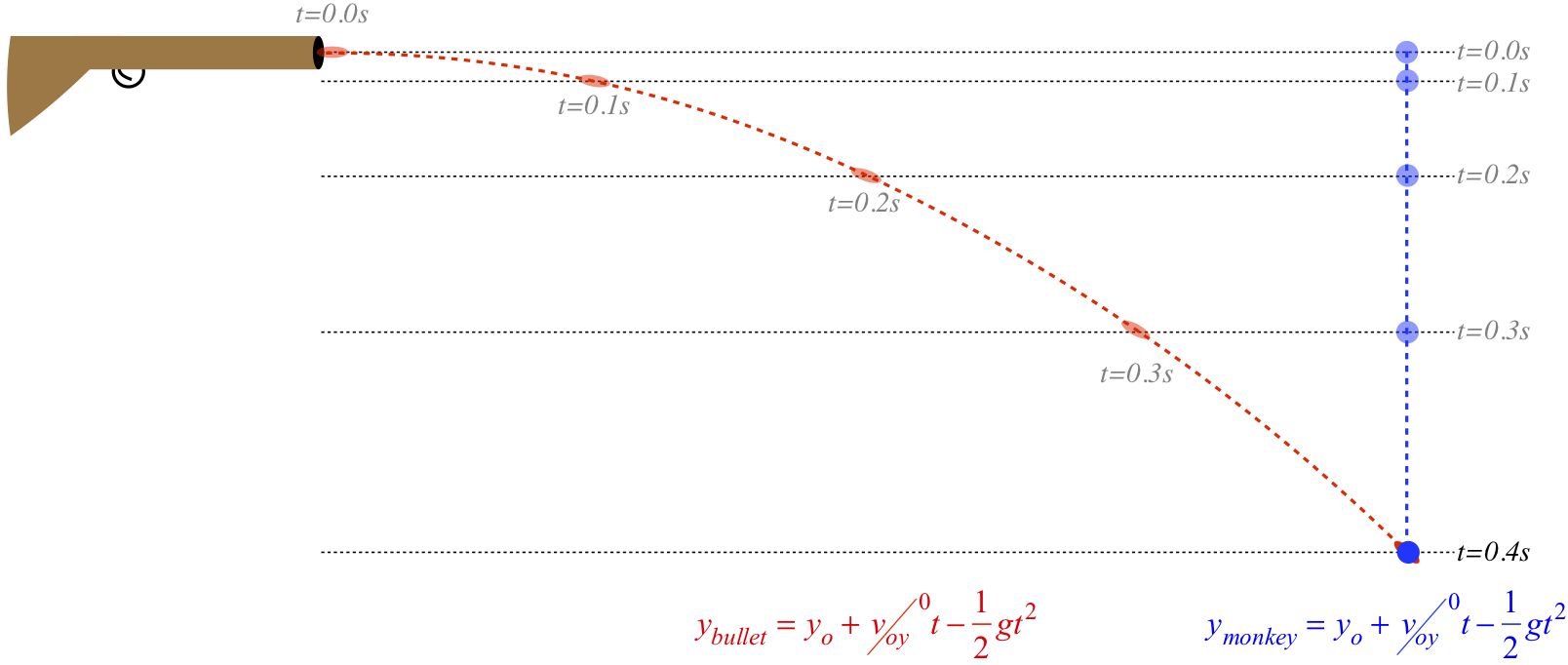
Example \(\PageIndex{3}\)
After falling out of the tree the last time he tried to shoot a monkey (his gun misfired), the hunter now decides to shoot a monkey from the ground. He is aiming upward at an angle, and is assuming the monkey will again let go of the branch just as the bullet is on its way. How should the hunter aim this time, if he is to bag his simian prize?
- He should aim right at the monkey.
- He should aim above the monkey.
- He should aim below the monkey.
- Unlike the level-shot case, where he should aim this time does depend upon how fast the bullet is coming out of the gun.
- The jerk should just aim at himself.
- Solution
-
A (and E). If there was no gravity, the bullet would follow a straight line to the monkey. With gravity acting straight down, the amount that the bullet drops below that straight line is the same that an object starting from rest on that straight line falls in an equal time. So the bullet and the monkey remain the same distance from the straight line at all times. When the bullet’s horizontal position equals the monkey’s horizontal position, they will coincide.
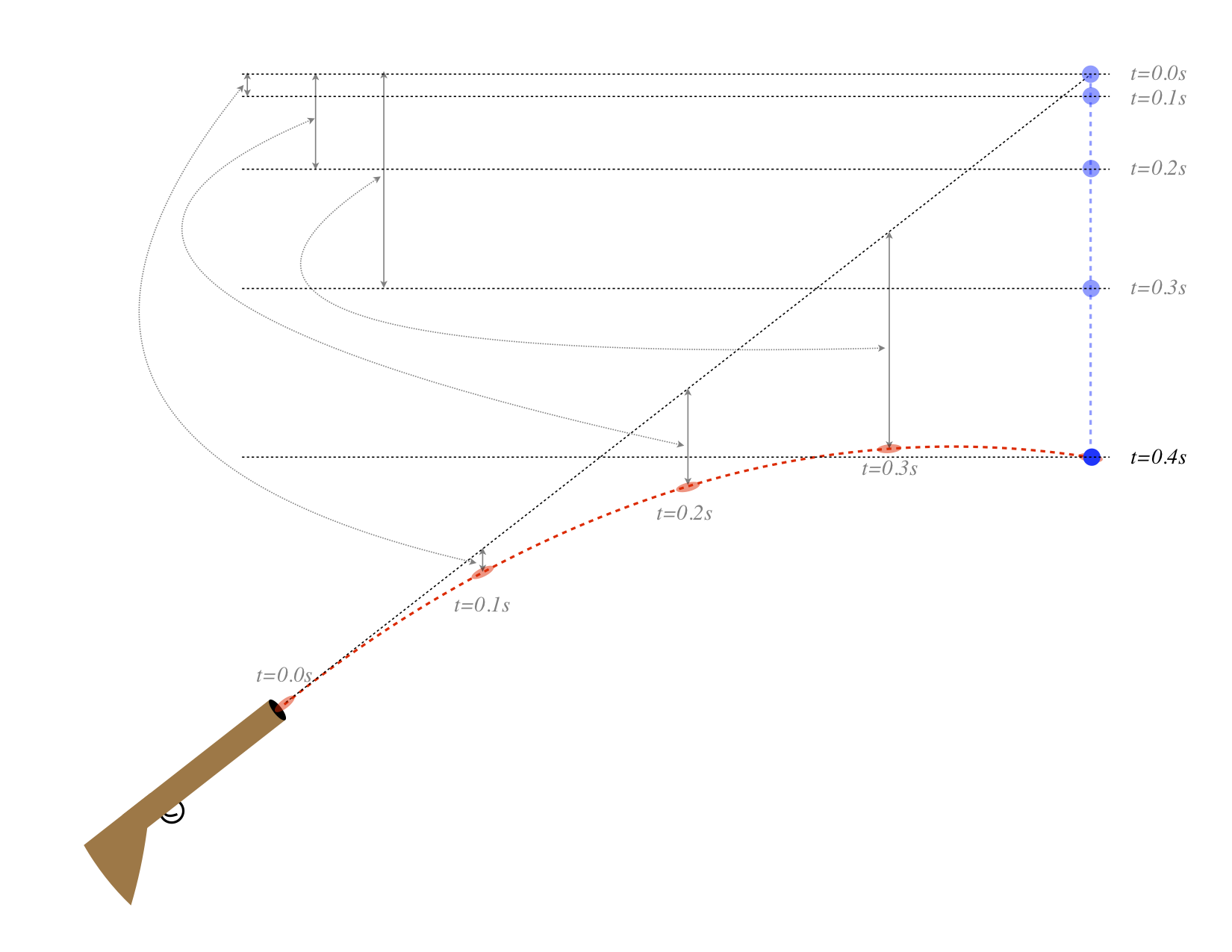
The only difference between this example and the previous one is that in the previous case, the line joining the barrel of the gun and the target was horizontal. Still, not everyone may be as convinced in this case as in the previous one, so let's do the math...
Suppose there is no gravity. The path that the bullet takes (\(y\) as a function of \(x\)) can be written down pretty easily. If the point where the bullet exits the barrel is chosen to be the origin, then the straight line to the monkey has a slope equal to the ratio of the vertical and horizontal components of velocity:
\[y=mx+b=\left(\dfrac{v_{oy}}{v_{ox}} \right)x \nonumber \]
Now suppose there is gravity. We have separate horizontal and vertical equations of motion. Again, with the bullet starting at the origin, we have:
\[x=v_{ox}t \\ y=v_{oy}t-\frac{1}{2}gt^2 \nonumber \]
Now solve for \(t\) in the first equation and plug it into the first term of the second equation to get:
\[y=\dfrac{v_{oy}}{v_{ox}}x-\frac{1}{2}gt^2 \nonumber \]
Comparing this with the first equation above, we see that the \(y\) value would follow the same straight line if not for the second term, and the amount that the height of the bullet \(y\) is decreased from that line after a time \(t\) is exactly the same distance that the monkey falls from that line in the same time.
With the number of variables and constants involved in projectile motion problems, there are countless ways to construct problems. There is no substitute for independent thinking and creativity, but the steps given below provide a good starting point for solving these kinds of problems.
- Draw a picture, labeling it as completely as you can, using information you have been given. Then spend some time thinking about what is happening – put yourself into the situation.
Alert
While this is given as a step for projectile problems, this is actually how you should start every physics problem!
- Pick an \(x\), \(y\) origin as well as \(+x\) and \(+y\) directions. Often for projectile problems up is chosen as the positive directions (making the acceleration due to gravity a negative value), but this is by no means required. What is important is that you use the positive direction consistently throughout the constants and variables in the equations.
- Break any initial velocities into components along the \(x\) and \(y\) directions.
- Write down the equations of motion, circling quantities that you know, and underlining the number you are looking for. If you have too many un-circled quantities for the number of equations available, you cannot yet do the algebra, so you’ll need to review the statement of the problem for any values concealed in the language of the problem (if you just scan a problem for numbers without carefully reading it, you will miss these).
- Solve the algebra and reconstitute components back into vectors, if necessary.
- Briefly check to see if the answer makes sense.
Alert
This is actually how you should end every physics problem!
One thing in projectile motion that is a useful tool is known as the range equation. This was of particular use to military firing cannonballs or (farther back in history than that), catapults. This equation relates the distance that a projectile will fly assuming it lands at the same vertical position that it started, given the starting speed of the projectile and the starting angle. Let’s treat finding this equation as if it was a projectile motion problem given to us, and follow the procedure outlined above
Problem: A cannonball is fired at an angle θ up from the horizontal at a speed of vo. Ignoring air resistance, how far does the cannonball travel before landing back on ground level with where it was fired?
A cannonball is fired at an angle \(\theta\) up from the horizontal at a speed of \(v_o\). Ignoring air resistance, how far does the cannonball travel before landing back on ground level with where it was fired?
- Solution
-
The diagram below labels the origin and the + directions. We are looking for \(R\) (referred to as the "range") in terms of the initial speed \(v_o\) of the projectile and the launch angle \(\theta\), which we treat as known values. The rest of the procedure is given below.
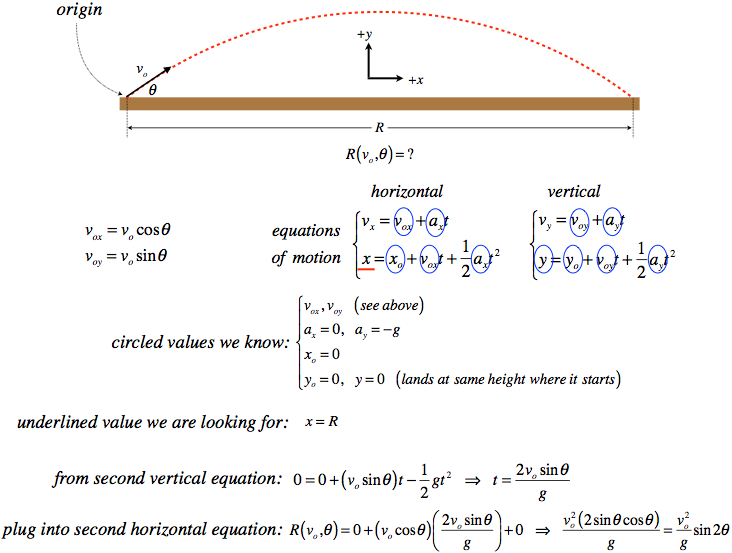
We can do other things with this result. For example, suppose we wanted to fire the cannonball as far as possible. Obviously we want it to start at the fastest possible speed, but given that, what angle should we aim at? Let’s solve it! We want to maximize the range R in terms of our choice of angle. This is a straightforward calculus problem. Take the derivative and set it equal to zero to find the maximum:
\[ 0 = \frac{dR}{d\theta} = \frac{v_0^2}{g}\frac{d}{d\theta}\big( \cos2 \theta \big) \big( 2 \big) \ \Rightarrow \ \boxed{\theta = 45^\circ}\]
This really shouldn't be too surprising, based on a simple symmetry argument: If we shoot the projectile with a really steep angle, it goes nearly straight up and doesn't travel very far. We can send the projectile the same distance by choosing a sufficiently shallow angle. That means that every landing point in range of the launcher has two possible distinct values for launch angle, except for the one corresponding to the longest range. It makes sense that complimentary launch angles reach the same landing point: \(89^o\) and \(1^o\), \(52^o\) and \(38^o\), and so on, which means that the self-complimentary angle of \(45^o\) hits the maximum range.
The following example is a challenging application of this principle, and gives an idea of the rich diversity of problems that can be conceived for projectile motion:
Example \(\PageIndex{5}\)
Two warlords aim identical catapults (i.e. they both release rocks at the same speed) at each other, with both of them being at the same altitude. The warlords have made the necessary computations to crush the other, and fire their catapults simultaneously. Amazingly, the two stones do not collide with each other in mid-air, but instead the stone Alexander fired passes well below the stone that Genghis shot. Genghis is annihilated 8.0s after the catapults are fired, and Alexander only got to celebrate his victory for 4.0s before he too was destroyed.
- Find the maximum height reached by each of the rocks.
- Find the amount of time that elapses from the launch to moment that the rocks pass each other in the air.
- Find the angles at which each warlord fires his rock.
- Solution
-
a. The time it takes a rock to travel to its peak height and back down again is equal to twice the time it takes to travel down from its peak height. Traveling down from its peak height, it starts with zero initial velocity, so we can calculate the height immediately for each rock:
\[ h_{A} = \frac{1}{2}g\left(\frac{t_A}{2}\right)^2 = \frac{1}{2} \left( 9.8 \dfrac{m}{s^2} \right) \left( \frac{8.0s}{2} \right)^2 = \boxed{78.4m} \\ h_{G} = \frac{1}{2}g\left(\frac{t_G}{2}\right)^2 = \frac{1}{2} \left( 9.8 \dfrac{m}{s^2} \right) \left( \frac{8.0s+4.0s}{2} \right)^2 = \boxed{176.4m} \nonumber \]
b. The x–components of the velocities of the rocks never change, and since it takes 12s for Genghis’s rock to travel the same horizontal distance as Alexander’s rock traveled in 8s, Alexander’s rock is traveling in the x-direction at a rate 1.5 times as great as Genghis’s rock is traveling in the x–direction. When they are at the same x–position (passing each other), the distance each has traveled is each one’s velocity times the time we are looking for, and we can express both of these distances in terms of the x–component of Genghis’s rock using the ratio described above:
\[ \begin{array}{l} x_A=v_{Ax}t, \;\;\;\;\; v_{Ax}=1.5v_{Gx} \;\;\; \Rightarrow \;\;\; x_A=1.5v_{Gx}t \\ x_G=v_{Gx}t \nonumber \end{array} \]
Since the rocks travel from both ends and are now at the same horizontal position, the sum of the distances they travel equals the total separation of the two warlords. This allows us to calculate the time:
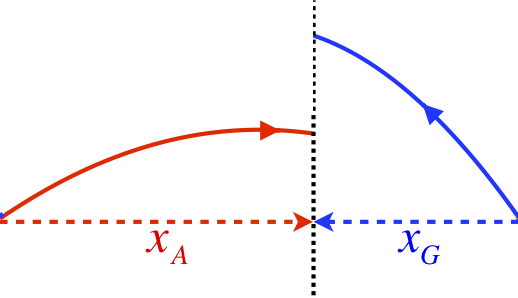
\[ x_A + x_G = x_{tot} = v_G t_{tot} \;\;\; \Rightarrow \;\;\; \left( 1.5v_G \right) t + v_G t = v_G \left( 12.0s \right) \;\;\; \Rightarrow \;\;\; t=\dfrac{12.0s}{2.5} = \boxed{4.8s} \nonumber \]
c. Clearly there are two different angles that will result in the rock traveling the same distance. One can see this from the range equation, but from a physical standpoint, this happens because one rock spends less time in the air but has a greater x–velocity, while the other spends more time in the air with a smaller x–velocity. To spend 1.5 times as long in the air, Genghis’s rock needs to start with 1.5 times as much vertical component of velocity as Alexander’s rock. This means that the ratios of the x and y components of the two rock velocities are inverses of one another, which means that the two angles are complimentary (i.e. \(\theta_A = 90^o – \theta_G\)). But the total speeds of the rocks are the same, so:
\[\left. \begin{array}{l} v_{Ax} = v_o \cos \theta _A = v_o \cos \left( 90^o - \theta _G \right) = v_o\sin \theta _G \\ v_{Gx} = v_o\cos \theta _G \end{array} \right\}\;\;\; \Rightarrow \;\;\;\dfrac{v_{Ax}}{v_{Gx}} = 1.5 = \dfrac{\sin \theta _G}{\cos \theta _G}\;\;\; \Rightarrow \;\;\;\left\{ \begin{array}{l} \theta _G = \tan ^{ - 1}1.5 = \boxed{56.3^o}\\ \theta _A = 90^o - \theta _G = \boxed{33.7^o} \end{array} \right. \nonumber\]


